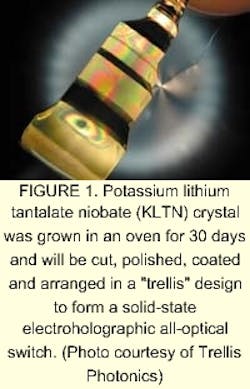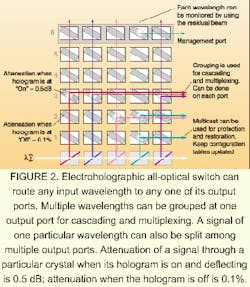Electroholographic switches are fast and compact
AHARON J. AGRANAT
Introduction of wavelength-division multiplexing (WDM) and optical-fiber amplifiers has boosted the volume of communications traffic that can be carried over long distances in fiberoptic networks. While these two technological innovations have made possible the effective exploitation of optical networks, thereby sustaining huge data traffic over long distances, the fact that the switching technology remains electronic is an inherent bottleneck. True all-optical switching requires a technology that is inherently different from that in today's optical-electronic-optical systems. It requires fast solid-state technology that has full network-monitoring and management capabilities.
The recognition of this problem initiated an intensive, worldwide R&D effort aimed at the development of all-optical-switching technologies. Most of the effort is focused on microelectromechanical systems (MEMS), but a variety of other technologies are also being pursued: for example, liquid crystals, bubbles, and silica-on-silicon thermally controlled waveguides. None of these technologies—including MEMS—provides the entire set of functions that is required of an all-optical switch.
A new all-optical-switching technology developed at Trellis Photonics promises to meet all next-generation switching requirements. Electroholography makes true dense wavelength-division-multiplexed (DWDM) switching possible by adding the wavelength dimension to photonic switching. In this way, electroholography supplies the missing function required of true all-optical networks.
Latent Bragg gratings
Electroholography exploits the voltage-controlled photorefractive effect in the paraelectric phase of a nonlinear optical crystal (see Fig. 1). The basic building block of an electroholographic device is an electrically controlled Bragg grating formed within such a crystal. The Bragg grating is stored in the crystal in a latent form as a trapped space charge. The application of a uniform electric field on the crystal activates the grating by inducing a modulation in its index of refraction spatially correlated with the trapped space charge.
When the grating is latent, an incoming monochromatic light beam incident at 45° to the input plane propagates unaffected through the crystal. Once the electric field that activates the grating is applied, the beam is diffracted and emerges from the crystal at 45° to the output plane (and 90° to the input beam). Such switching occurs only if the beam angle of incidence and wavelength match the Bragg condition of the grating. Thus, if the input beam consists of a multiple-wavelength WDM signal, only one wavelength will match the Bragg condition; as a result, the application of the field will cause only this WDM component to be switched. Because the strength of the applied field determines the diffraction efficiency, the electroholographic device can be used as a variable attenuator as well as an optical switch. Consequently, the electroholographic device acts as a wavelength-selective switch with variable efficiency.
The electroholographic devices are formed in an electro-optic crystal developed for this purpose. Invented by the author while at the California Institute of Technology (Pasadena, CA), the crystal—potassium lithium tantalate niobate (KLTN) doped with copper and vanadium—was further developed and investigated at the Hebrew University of Jerusalem. A photorefractive crystal, KLTN resides in its paraelectric phase at room temperature and has a very-high optical quality and large dielectric constant. The copper-vanadium-doped KLTN is unaffected by the wavelengths used in fiberoptic communications networks (1.31 and 1.55 µm). Therefore, the erasure during readout that is typical to photorefractive volume holograms does not occur here.
Thus, KLTN enables the transformation of electroholography from an abstract concept into a viable technology. Unlike other devices purporting to perform all-optical switching, an electroholographic switch eliminates the need to convert optics to electronics in a network. It operates at nanosecond speed, orders of magnitude faster than other optical switches. It offers testing, measurement, and dynamic attenuation of every wavelength in the switch.
Electroholography is the core technology within a solid-state optical switch from Trellis Photonics called the intelligent lambda switch (ILS). The characteristics of the device make it capable of network monitoring at a protocol level. It uses KLTN crystals arranged in a matrix of rows and columns—like a garden trellis—to deflect specific wavelengths of light from one fiber to another (see Fig. 2). The columns represent individual wavelengths; the rows, individual fibers. When no voltage is present, a crystal is essentially transparent and the Bragg grating is latent. When voltage is applied, the Bragg grating becomes active and deflects the wavelength into the appropriate fiber. Traffic management, therefore, is dynamic. The electroholographic array possesses several unique features. In particular, since the single switches are wavelength-selective, the array can group together several wavelength components into the same output fiber and multicast one wavelength component into several output fibers.
Switches are fast and compact
As a result of the high transmission characteristics of the crystals, large multistage configurations can be designed from arrays of crystals, resulting in a large switching scalability. In each state, a different set of holograms is activated to direct the light beams in the required three-dimensional angles to the next stage. In other words, the switches contain the routing spatial information, eliminating the need for additional optics between the stages and permitting a wide variety of interconnect configurations—while maintaining compact dimensions—for a large number of nodes. The switches are transparent to the data bit rates as long as diffraction occurs. Data throughputs of greater than 100 Gbit/s can be supported.
The electroholographic switching mechanism deflects 90% of the light, allowing 10% to travel to the end of a row where it can be sent to a local testbed or amplified and transmitted to a central network-operations center. The ILS also monitors and manages the varying power levels of all the wavelengths being routed to a fiber, ensuring that they are ready for delivery to the DWDM network. It enables operators to do nonintrusive, protocol-level remote testing of every wavelength in a network.
Electroholographic arrays are manufactured using standard pick-and-place techniques. The gratings are written into the crystal in the final stage of the fabrication process. The performance of the electroholographic array is monitored during the iterative writing procedure, permitting a final optimization of the device performance that substantially increases the fabrication yield.
It should be emphasized that electroholography is a generic technology that opens several different avenues of applications in the arena of DWDM networks. Although the ILS itself is planned for circuit-switching applications, the rapid switching speeds made possible through electroholography make it a technology that enables packet switching as well. In addition, more-complex switching architectures can be put in place by storing more than one grating in a crystal.
Aharon J. Agranat is director at Trellis Photonics Inc., 10025 Governor Warfield Parkway, Suite 400, Columbia, MD 21044; e-mail: [email protected].

